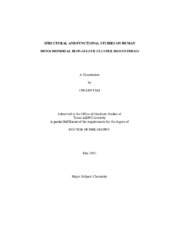| dc.description.abstract | Iron-sulfur (Fe-S) clusters are critical protein cofactors found in all life forms. In
eukaryotes, a well-conserved biosynthetic pathway located in the mitochondria is used to
assemble Fe-S clusters. Although proteins required for Fe-S cluster biosynthesis have
been identified, their precise function and mechanism remain elusive. In this study,
biochemical and biophysical methods are applied to understand molecular details for the
core components of the human Fe-S cluster biosynthesis: Nfs1, Isd11, Isu2, and frataxin
(Fxn). Nfs1 is a cysteine desulfurase that converts cysteine into alanine and transfers the
sulfur to a scaffold protein Isu2 for Fe-S clusters. Fxn depletion is associated with the
neurodegenerative disease Friedreich’s ataxia (FRDA), and results in a complicated
phenotype that includes loss of Fe-S clusters.
The results presented here provide the first in vitro evidence for a stable protein
complex that exists in at least two forms: an inactive complex with Nfs1, Isd11, and Isu2
(SDU) components and an active form that also includes Fxn (SDUF). Fxn binding
dramatically changes the catalytic efficiency (kcat/KM) of Nfs1 from 25 to 10,100 M-1s-1 and enhances the rate of Fe-S cluster biosynthesis 25 fold. Oxidizing conditions diminish
the levels of both complex formation and Fxn-based activation, whereas Fe2 further
stimulates Nfs1 activity. Mutagenesis coupled to enzyme kinetics indicate that one of the
three conserved cysteines (C104) on Isu2 accepts the sulfane sulfur from Nfs1 and that
this transfer event likely requires prior binding of Fxn. In vitro interrogation of FRDA
I154F and W155R and related Fxn variants revealed the binding affinity to SDU
followed the trend Fxn ~ I154F > W155F > W155A ~ W155R. The Fxn variants also
have diminished ability to facilitate both sulfur transfer and Fe-S cluster assembly. Fxn
crystallographic structures reveal specific rearrangements associated with the loss of
function. Importantly, the weaker binding and lower activity of the W155R variant
compared to I154F explains the earlier onset and more severe disease progression.
Finally, these experimental results coupled with computational docking studies suggest a
model for how human Fxn functions as an allosteric activator and triggers sulfur transfer
and Fe-S cluster assembly. | en |


